Analysis of the “Berton’s Report” film sequence from “Solaris” directed by Andrei Tarkovsky (1972)
“I want to emphasize yet again that, […], cinema is an art which operates with reality…”
(A. Tarkovsky 1989: 177) [1]
I. Introduction
Andrei Tarkovsky is one of my favorite directors. I admire his films. However, to interpret and analyze the art of a great master might be a dangerous task. It is easy to choose a wrong method for the analysis, which might be against the worldview of the master. In order to avoid this, I decided to use Tarkovsky’s own reflections about the cinema (Sculpting in Time) as a guide, keeping in mind his opposition to the structuralist interpretation of a single frame, and rather looking to find the inner structure of interconnected motifs.
In this work I will focus on the sequence of shots where pilot Henri Berton (Vladislav Dvorzhetsky) [2] shows a documentary film reporting his flight to the planet Solaris to the main character of the film, psychologist Kris Kelvin (Donatis Banionis). I have named this sequence “Berton’s Report.” This sequence plays a pivotal role in the narrative structure of the film. It introduces us to both the planet Solaris, and one of the central concerns of the film, namely, that planet Solaris might be a gigantic cerebral system. The sequence lasts fourteen minutes and thirty-three seconds, consists of 66 shots, and is a combination of black and white and color shots. [3]
…The film started ten minutes ago. We are somewhere in the forest near the lake, where Kris’s parents have built their wooden family house. Psychologist Kris Kelvin has his last day on Earth, before leaving for the space station that orbits Solaris. There is a suspicion that the three remaining scientists on the space station somehow became mentally sick as a result of the planet Solaris. Kris needs to check the situation and make the final decision about the fate of the station. An old friend of Kris’s father, pilot Henri Berton, arrives with a videotape, which he wants to show to Kris. On the tape is Berton’s report to the scientific commission about his flight to Solaris, which includes video images of the planet which he filmed and his own explanation of the images.
…The scene begins with Kris’s father sitting on the couch in a room in the family house. The videotape with “Berton’s Report” has just started and the father stands up and leaves. Kris’s aunt Anna (Tamara Ogorodnikova), Kris, and Henri Berton take their seats in front of the TV (video) screen (for complete shot references please see Sequence Protocol at the end of the essay).
II. Analysis of the “Berton’s Report” film sequence
1) Three different Realities and their rhythmical interchange
To begin, there are three different fictional realities in the sequence’s diegesis :
1)“ Reality I”: the room in Kris’s parents house, where the film “Berton’s Report” is shown.
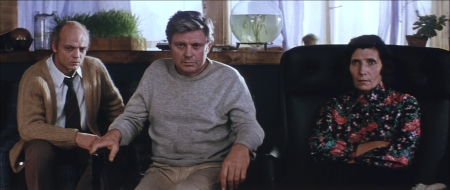
2) “Reality II”: the meeting of the scientific commission, where Berton’s reports about his flight to Solaris is shown.
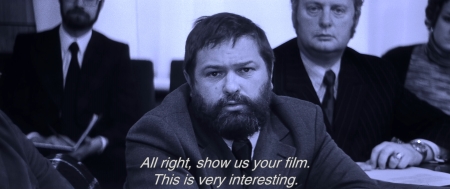
3) “Reality III”: the planet Solaris, shot by Berton’s camera.
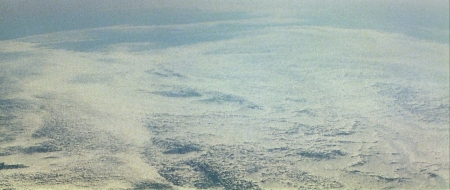
Reality I (colored blue in the Sequence Protocol) consists of 19 shots (17 full ‘Reality 1’ shots and 2 with “mixed” Reality), namely shots: 1, 2 (mixed: this shot also contains Reality II on the TV screen), 6, 10, 12, 14, 15, 20, 22, 30, 36, 37 (mixed: this shot also contains Reality II on the TV screen), 39, 45, 47, 52, 57, 60, 66. All shots inReality I are medium to close up, with dominant central composition. Reality I constitutes about 29% of the entire sequence; it is shot always in one room and has only interior shots.
Reality II (colored green in the Sequence Protocol) has 44 shots (41 full shots and 3 mixed), namely shots: 2 (exists within Reality I on the projection screen), 3, 4, 5, 7, 8, 9, 11, 13, 16, 17, 18, 19, 21, 23, 24, 25 (also contains Reality III on the TV screen), 26, 33, 34, 35, 37 (also contains Reality II on the TV screen), 38, 40, 41, 42, 43, 44, 46, 48, 49, 50, 51, 53, 54, 55, 56, 58, 59, 61, 62, 63, 64, 65. All shots in Reality II are medium to close up, with dominant central composition). They constitute about 68% of the entire sequence.
Reality II is constructed from interior shots taken in four different spaces:
- In the conference hall where we see a round table and video screen. We see the young pilot Berton alone and with other scientists in this space, including Professor Messenger. It has 24 shots (9, 11, 13, 16, 17, 19, 21, 24, 25, 33, 35, 38, 40, 42, 44, 46, 48, 50, 54, 56, 58, 61, 63, 65).
- In the room with a square table. In this space we see Scientist #3. It has 8 shots (23, 34, 49, 53, 55, 59, 62, 64).
- In the hall with a long corridor. In this space we see Scientist #1. It has 4 shots (3, 5, 7, 41).
- In the hall with the window at the back. In this space we see Scientist #2. It has five shots (4, 8, 18, 43, 51).
Reality III (in orange color) consists of 6 short shots (5 full exterior shots and 1 shot within Reality II on the TV screen), namely shots: 25 (this shot exists within the Reality II on the TV screen), 27, 28, 29, 31, 32. Reality III constitutes 9% of the entire sequence. Some special effects are applied to the shots in Reality III.
Shots of mixed Realities are 2, 25, 37: two shots of mixed Reality I and Reality II (2,37), and only one shot of mixedReality II and Reality III (37). Mixed Realities constitutes about 5% of the whole sequence. The mixture of the Realities is achieved through the use of the TV (video) screen. For example, in the room with Reality I, a TV (video) screen is placed that shows the environment of Reality II, etc.
Each of these three Realities has its own characters: In Reality I we see Kris Kelvin, his father, his aunt, and the older Henri Berton. In Reality II we see a young Henri Berton, and many different members of the scientific commission, both males and females (since only one member of the scientific commission has a name, Professor Messenger, I gave the other six talking members of the commission the following names: Scientist #1, Scientist #2, Scientist #3, Scientist #4 (off screen), Scientist #5, Scientist #6, and Secretary (female)). Altogether eight men and one female talk in Reality II. Reality III has only one character – the ocean Solaris. Reality III consists of exterior shots and contains full close and full wide shots.
If we look at the rhythmical interchange between Realities I, II, and III (Graph 1), we can observe its connection to the “triangle” dramatic structure of the sequence.
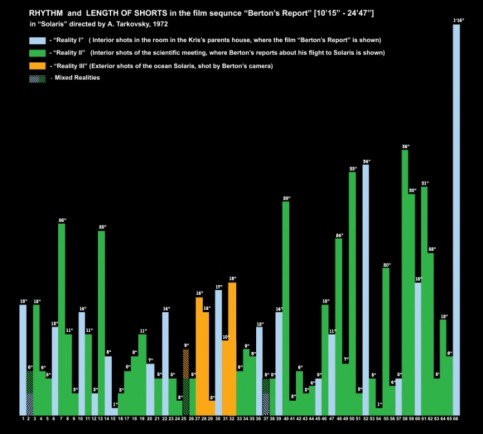
Shots 1-26 (blue and green) introduce us to the sequence’s problem, by giving us the background story of Berton’s flight to Solaris; shots 25, 27-29, 31 and 32 (orange) contain the controversial video from the planet Solaris, constructing the main conflict of this sequence and of the entire film; and finally, shots 33-66 (blue and green) show the scientific debates around Berton’s Report, contributing to the growth of the psychological tension and pressure within Reality II. Through the video screen this tension affects people in Reality I and most importantly the main character of the film, Kris Kelvin. Reality III (orange) is situated almost in the middle of the sequence, culminating as a climax in the “triangle” dramatic structure of the sequence. The total silence of the shots of Solaris (Reality III) creates a mysterious “attractor” and deepens the spatial and dramatic structure of the sequence and the entire film. The allocation of the Mixed Realities also contributes to the “stability” of the “triangle” dramatic structure of the sequence (introduction, conflict, and resolution). We see the first mix of Reality I and Reality II at the beginning (shot 2, see Sequence Protocol), followed by the mix of the Reality II and Reality III (shot 25), and then we have the “return” – again the mix of Reality I and Reality II (shot 37).
Towards the end of the sequence the density of the “long” takes grows. The last shot (shot 66) is the longest one (one minute and sixteen seconds). However, “the rhythm is determined not by the length of the edited pieces, but by the pressure of the time that runs through them” (Tarkovsky 1986: 117). The time pressure here is regulated by the camera movements, which contribute to the construction of emotional and physiological expression of the situation. At the beginning, the camera moves seldom and smoothly, towards the end it starts to pan roughly and fast (shots 33, 35, 37 (in Reality II), 46, 61).
“In so far as sense of time is germane to the director’s innate perception of life, and editing is dictated by the rhythmic pressures in the segments of film, his handwriting is to be seen in his editing. It expresses his attitude to the conception of the film, and is the ultimate embodiment of his philosophy of life” (Tarkovsky 1986: 121). One of the famous characteristics of Tarkovky’s handwriting is central composition. We have observed it in the “inner” montage structure of the “linear” disposition between Realities I, II and Reality III (see Graph 1 above), with Reality III beginning in the center, creating a mysterious attractor. Now let’s look at the central composition in the spatial connection betweenReality I, Reality II, and Reality III.
2) Connection between different realities through video screens
Diagram 1 below shows the conceptual representation of the connection between Realities I, II, and III in the fictional diegesis. The realities are connected through video screens (screen 1 and screen 2) with the help of constantly interchanging point-of-view shots of their characters.
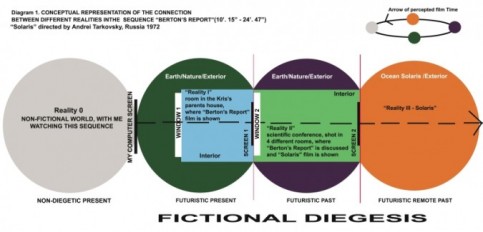
“Cinema is the one art from where the author can see himself as the creator of an unconditional reality, quite literally of his own world […] A film is an emotional reality, and that is how the audience receives it – as a second reality” (Tarkovsky 1986: 176).
In the case of this particular sequence, within this “second” reality, three other realities (Reality I, II, and III) coexist. Hence it would be appropriate for the analysis of this sequence to name the audience reality –my reality, the reality of the world where I am sitting and watching the sequence through my computer screen– “Reality 0” in the non-diegetic space (see Diagram 1). I am in front of my computer (or television screen), facing it. I am in the center. I turn on the video with the sequence “Berton’s Report” and watch the other realities (going in and out from one to another). First I am presented with the Reality I in Kris’s parents house (shot 1), then I am presented with the video screen in the Reality I, that shows Reality II (shot 2), then I am presented with the video screen in Reality II, through which I am observing Reality III (shot 25), etc. Due to the central composition of the position of video screens in the fictional diegesis, I find myself located on the central axis, aligned with the fictional realities. Moreover, each reality, including mine, has its own time: Non-fictional present (Reality 0), fictional futuristic present (Reality I), fictional futuristic past (Reality II), and fictional futuristic remote past (Reality III). It presents us, first of all, with the “communication tunnel between time and space” and second with a “closed circle of time” (Diagram 1, upper right corner) with the counterclockwise time arrow. I can even say that this can be read as a symbol of the “eternal return,” a “snake of time biting its tail,” an eternal cycle of time.
Reality I and Reality II are shot in interior spaces, but the actual windows depicted within them can be also read as screens, positioned on the central arrow that penetrates the spaces of the different realities (Diagram 1, Conceptual Drawing 1). The concept of the central arrow emphasized by the position of Window 1 in the Reality I (a window in Kris’s father house, located behind the couch where Kris, his Father, his Aunt, and Berton sit), just opposite the position of the Screen 1, and Window 2 in the Reality II (a window in one of the conference rooms), just opposite the Screen 2 (Diagram 1, Conceptual Drawing 1). Window 2 in Reality II coincides with the position of Screen 1 in theReality I (shot 2, shot 36), positioned on the “back side” of it (shot 26, with the man and a black crow behind the window).
The positions of the Screens 1 and 2, and Windows 1 and 2 contribute to the creation of the “communication channel” between Realities I, II, and III. The position of my viewing screen coincides with the position of the Window 1, positioned virtually on the back of it (shot 2). This creates a subtle “communication link” across time and space.
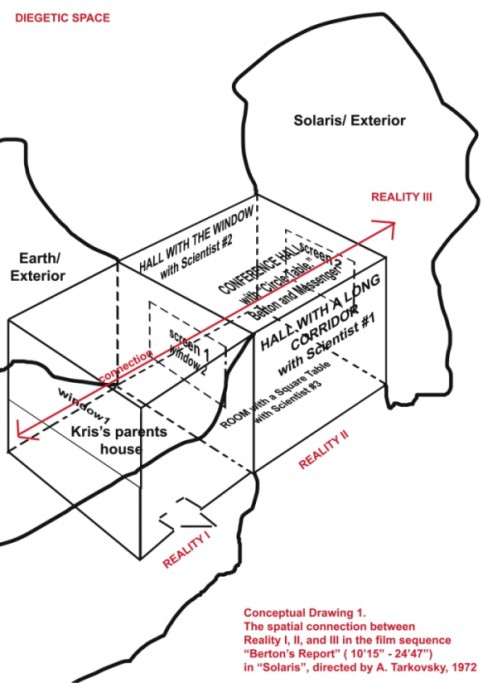
The Mixed Realities shots (shots 1, 25, 37) function not only as three stable points in the sequence that define the time and space arrow, which links together realities, but also fulfill Brecht’s “A-Effect” by distancing the viewer from total emotional involvement.
If we think further, we can even assume the existence of a spatial virtual connection between the “Solaris/ Exterior” and “Earth/ Exterior” similar to the “Time Ring” in Diagram 1. “Time and memory merge into each other; they are like the two sides of a medal. It is obvious that without time, memory cannot exist either” (Tarkovsky 1986: 57). “Once seen and recorded, time could now be preserved in metal boxes over a long period (theoretically forever)” (Tarkovsky 1986: 62). These two expressions from Tarkovsky are very well suited to the “Berton’s Report” sequence. Time and memory are preserved here in the ‘boxes’ of realities.
The sequence’s conceptual principle is the binary opposition, which we can see in the use of the “mirror” effect (example shots 9, 10, and 56, 57). While old Berton in Reality I is “communicating” (facing) with young Berton inReality II and his memories, others in Reality I are learning new information about him and Solaris. Berton “is thus, and twice, doubly subject and object.” [4]
Especially interesting is the construction of the Reality II, which occupies the biggest part of the entire sequence at 63%. Reality II is constructed from the communication between scientists in four different spaces (scientific halls) that presumably lead their conversation through an invisible screen. The switch between their spaces can be recognized only through the beep sound (shots 3, 8, 9, 18, 23, 33, 41, 42, 43, 59, 62, 63). Tarkovsky’s construction of theReality II can be presented as a conceptual cube, where four sides of it represent the screens of four different spaces (see Conceptual Drawing 1). From these spaces scientists express their opinions about Berton’s flight to Solaris. On two other “walls” of Reality II are positioned Window 2 and Screen 2. The opposition between talking Scientist #1 and Scientist #2 (extremely noticeable in the mirroring gestures of Scientis #1 and Scientist #2 in shots 4 and 5), and between Berton (together with Prof. Messenger) and Scientist #3 are presented by the use of the central composition in the frames and constant interchange of the characters’ point-of-view shots.
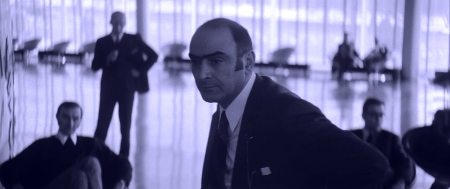
It is interesting that the position of me as a viewer during the duration of this sequence changes. Sometimes I find myself in my Reality 0, observing what is happening in the cubes with Reality I and II (shot 2), then in Reality II, where I am placed in between Scientist #1 and Scientist #2 (shots 3-5), observing them from their interchanging point-of-view shots. Then I migrate to the position “within” the Screen 1, from where I am “secretly” observing the characters inReality I (shot 6) and characters in Reality II. And finally, from my position within Screen 1, I observe Reality III, projected on Screen 2 (see Conceptual Drawing 1).
Tarkovsky positions the main character of the film, Kris Kelvin, at the beginning of the central axis connecting realities. Kelvin is the one who sits on the coach in Reality I in front of Screen 1, and virtually in front of Screen 2 (on the central communication arrow between Reality I, Reality II, and Reality III). His position in the centre is justified: he actually needs to be “connected” to Solaris in order to make the correct decision about the fate of the orbit station above it.
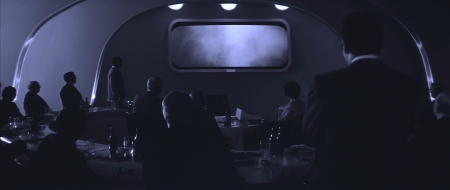
Finally, I would like to mention that in this sequence Tarkovsky focuses not only on constructing “the mirror” effects of oppositions, but also aims at the demolition of the barriers of time and space between Reality I and Reality II. He achieves this by:
- 1) the creation of homogeneous framing in Reality I and II – most of the shots are medium close shots in Reality I and II;
2) the dialog, for example Kris’s aunt asks the question “What do you mean?” in Reality I, and is answered in Reality II (shot 47). In shot 45 Kris looks at old Berton in Reality I, then looks at the screen 1 and asks young Berton a question, then looks again at the old Berton. In shot 14 Kris addresses old Berton with a question, and instead of the answer, old Berton (shot 15) points (nods) with his head to the screen, where young Berton answers the question (shot 16). [represented in stills below]
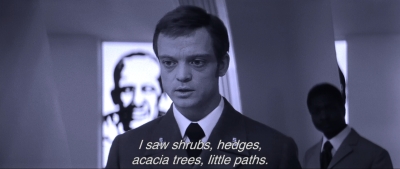
Even though most of the shots in Realities I and II are in the medium shot range, corresponding to the concept of TV screen shots of the “talking heads,” it doesn’t seem repetitive because the connection between shots representing different realities is complicated and multilayered.
3) Color in Reality I, Reality II, and Reality III
“One of the greatest difficulties in the graphic realization of a film is, of course, color. Paradoxically, it constitutes a major obstacle to the creation on screen of a genuine sense of truth…The perception of color is a physiological and psychological phenomenon to which, as a rule, nobody pays particular attention…You have to try to neutralize color, to modify its impact on the audience…Why is it, when all that the camera is doing is recording real life on film, that a colored shot should seem so unbelievably, monstrously false? The explanation must surely be that color, reproduced mechanically, lacks the touch of the artist’s hand; in this area he loses the organizing function, and has no means of selecting what he wants” (Tarkovsky 1986: 138).
“Strangely enough, even though the world is colored, the black and white images come closer to the psychological, naturalistic truth” (Tarkovsky 1986: 139).
These statements help explain why in the sci-fi futuristic past Tarkovky uses the black and white footage. The shots of Reality II portray Berton’s psychological inner state and they are in accordance with Tarkovsky’s belief about cinematic color and black and white. Berton has encountered something great on Solaris: frighteningly magical phenomenon that gave him another perspective on the meaning of life. To open up his inner state to Kris is difficult. Everything needs to be naturalistic and true and this can be achieved only by eliminating the “artificial” colors. It is interesting that the main character, Kris Kelvin, is wearing a somewhat grayish sweater, connecting him to the black and white color palette of the Reality II. Reality III has some homogeneous grayish colors, which makes it a form of color “link” between Reality Iand Reality II.
4) Other observations and details
After watching this sequence many times, I was excited to discover that Tarkovsky takes part in this sequence. Off screen one can hear him in the role of Scientist #4 (shots 36, 37 and most likely also 46). Here the director communicates the most important statement of the film: that the planet-ocean Solaris is a substance capable of thought process. This gives “Berton’s Report” sequence a double meaning in the context of the film.
Another interesting observation is the “coded” connection between Soviet cosmic science and exploration. In shot 13 Berton is positioned between the portraits of Konstantin Tsiolkovsky, the Russian imperial rocket scientist, and Yuri Gagarin, the first man in space.
A final observation relates to the cinematographer Vadim Yusov, who rarely holds his camera completely still when shooting dialog scenes. His camera always makes slight (almost unnoticeable) pans. We all know that the human cannot be absolutely still. With these pans, the camera portrays the movements of the “observing” human. There are also several swish pans in Reality II, whereas in Reality I the pans are slower, creating more of a sense of connection between the three characters. The swish pans in Reality II evoke the tension between the characters. Also, there are several zoom shots in Reality II, but none in the other scenes.
III. Conclusion
Tarkovsky uses video screens and shots in three different realities to create a “communication tunnel” between the fictional present, fictional past, fictional remote past, and eventually between our non-fictional present, as well. He achieves this by using the central composition and positioning the diegetic video screens along the central axis that runs through Reality I and Reality II, ending up in the unknown reality of Solaris (Reality III) (see Diagram 1). In this sequence, Tarkovsky achieves a multilevel deepening of cinematic space. This depth goes beyond the usual “second” reality that we are used to experiencing in films. The “depth” of the “Berton’s Report” sequence reminds me of the principle of Russian Matryoshka dolls, where one doll appears from inside another, etc. By positioning the shots ofReality III in the middle (center) of the sequence, Tarkovsky makes of them the dramatic attractor. The absence of any sound in them creates a necessary tension in the dynamic rhythmical composition of the sequence. The camera movements (pans) that become rougher and faster towards the end of the sequence reflect the physiological tension within Reality II and Reality I.
The complexity of the construction of Reality II makes it the special spatial structure within the entire sequence. Reality II serves as a primary link between Reality I and Reality III, corresponding between Kris Kelvin and Solaris (Conceptual Drawing 1). Therefore, an important connection is made: the reality of Earth (Reality I), with its nature behind Window 1, around Kris’s parental home, is connected to the Reality III of Solaris. At the end of the film, the circle of time and space will be closed, when through Window 1, Kris will see the Reality I of his parent’s house, himself and his father, materialized by Solaris.
In this context, I dare to assume that Solaris and Earth are connected through the “communication channel” located in the Reality II “closed” interior space, which is actually constructed from shots of four different spaces (see Conceptual Drawing 1). This “channel” is also important for the dramatic structure of the entire film. Through Reality II, Kris gets a view of Reality III and collects some important information about Solaris, which will be useful for him and the audience later in the film.
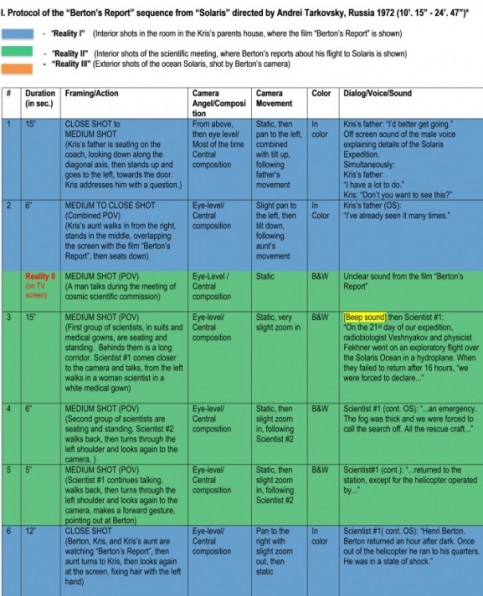
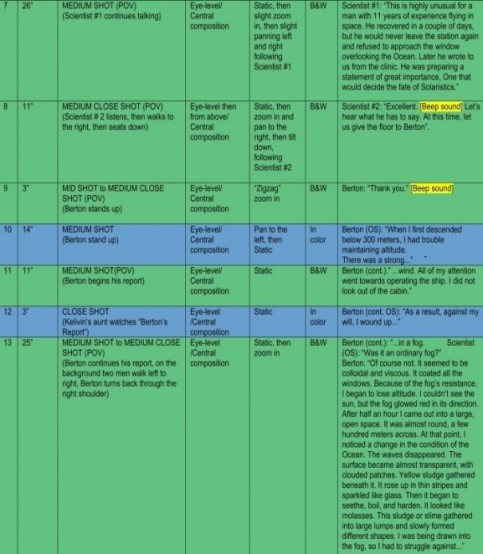
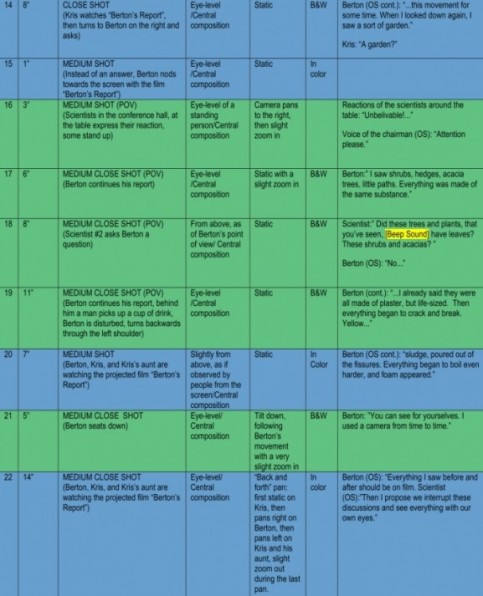
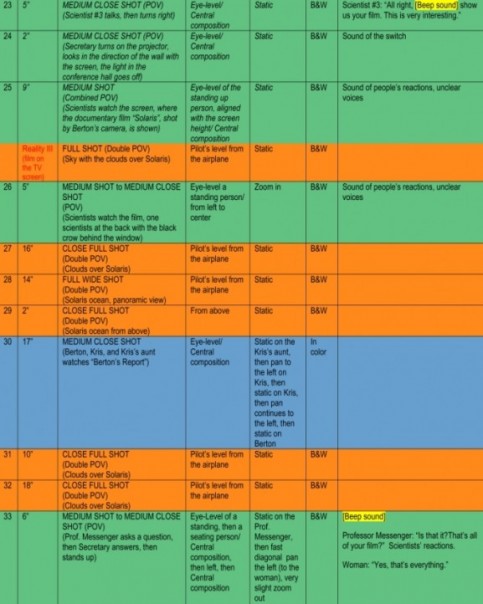
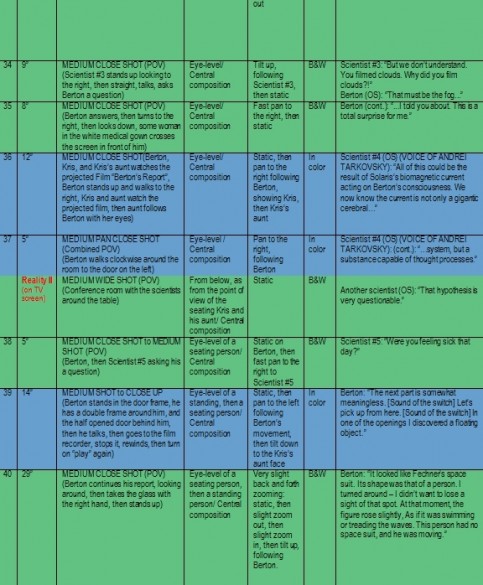
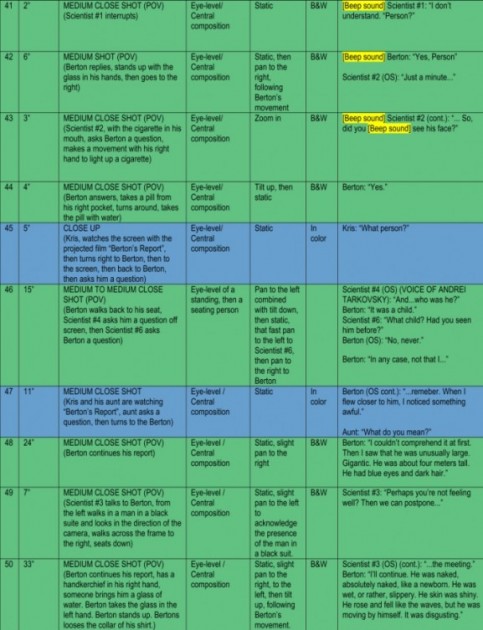
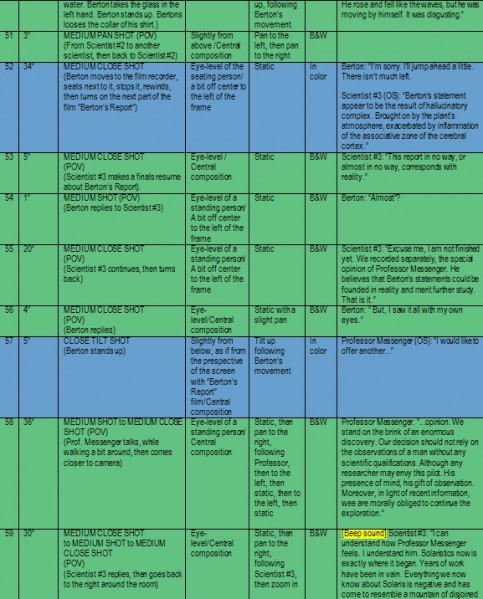
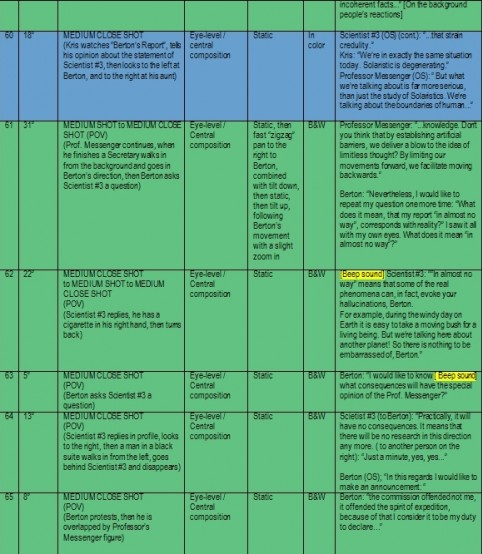
- Endnotes
- 1 Tarkovsky, Andrey (1986). Sculpting in Time, Reflections on the Cinema, University of Texas Press, Austin, USA, p. 254.
- 2 “Solaris”, Plot Summery, IMDb. The time code for this sequence on the most recent Criterion Blu-ray is approximately 11’08”-26’00”.
- 3 Film source: “Solaris” (1972)
- 4 Bellour, Raymond (2000). The Analysis of Film, Indiana University Press, USA.

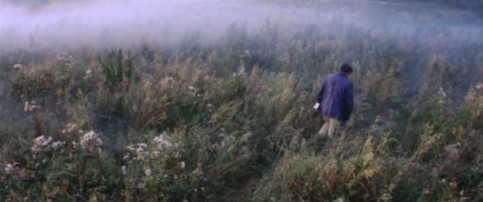
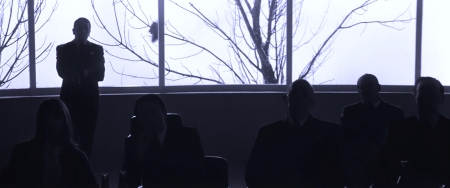
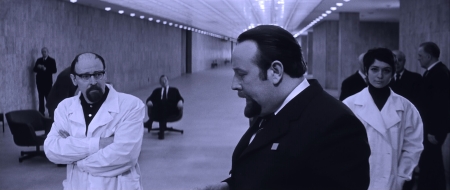
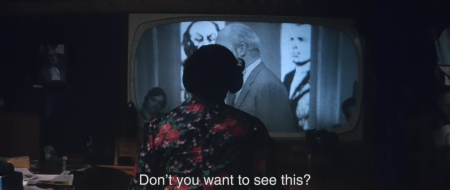
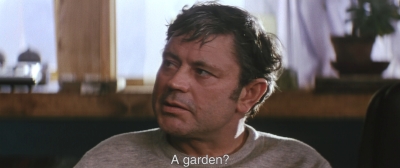
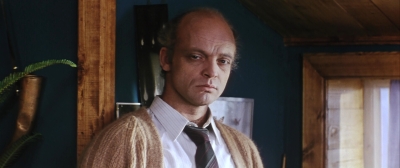
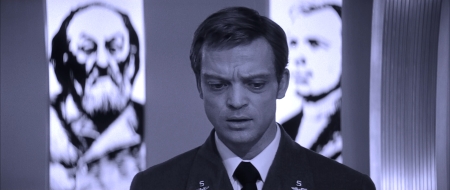
You must be logged in to post a comment Login